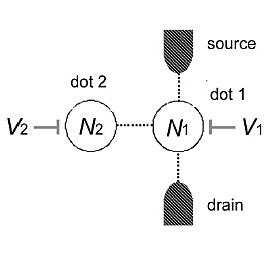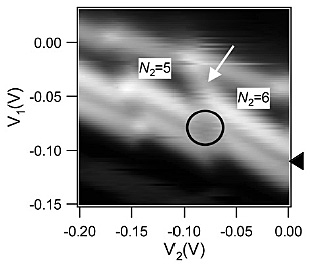Physical Science Laboratory
Large tunability of electronic states in semiconductor quantum dot (QD)
systems has unveiled rich quantum transport phenomena such as the Kondo
effect and Fano resonances. The Kondo effect arises from spin singlet formation
between the localized magnetic moment in the QD and the conduction electrons
in the reservoirs, and drastically modifies the transport characteristics
of the QD at low temperature. When a second QD (dot 2) is tunnel-coupled
to the side of the first QD (dot 1) exhibiting the Kondo effect, as schematically
shown in Fig.1, the inter-dot spin singlet formation is expected to suppress
the Kondo effect. Although a large number of theoretical studies exist
on such a side-coupled double QD, very few experiments have been reported
so far. On the other hand, Fano effect arises from interference between
continuum and a resonant channel. Ratio of the transmission amplitudes
via the two channels determines the Fano resonance wave form ranging from
an asymmetric peak to a dip.
In this work, we measure low temperature transport characteristics of
the side-coupled double QD fabricated from GaAs/AlGaAs two dimensional
electron system, and discuss novel Fano-Kondo interplay [1]. Figure 2 shows
a grey-scale plot of the conductance as functions of the plunger gate voltages,
V1 and V2, measured with a standard lock-in method at 41 mK. Three strong Coulomb
peaks are observed when the electron number in dot 1, N1, changes by one. Conductance between the two Coulomb peaks marked with a triangle is enhanced by the Kondo effect where N1 is odd. Inter-dot Coulomb interaction is revealed as jumps in the Coulomb
peak positions whenever the electron number in dot 2, N2, changes by one, forming a well-known honeycomb stability diagram. We
observe conductance maxima at the upper valley (white arrow) and minima
at the lower valley (black circle) when N2 changes by one. Detailed temperature and magnetic field dependence measurement
of these features lead us to conclude that they are Fano resonances where
the Kondo effect (cotunneling) in dot 1 plays a role of continuum. These
features are qualitatively reproduced by theoretical calculations [2].
[1] S. Sasaki et al., Phys. Rev. Lett. 103 (2009) 266806.
[2] H. Tamura and S. Sasaki, Physca E 42 (2010) 864.
 |
 |
|||||
|
|